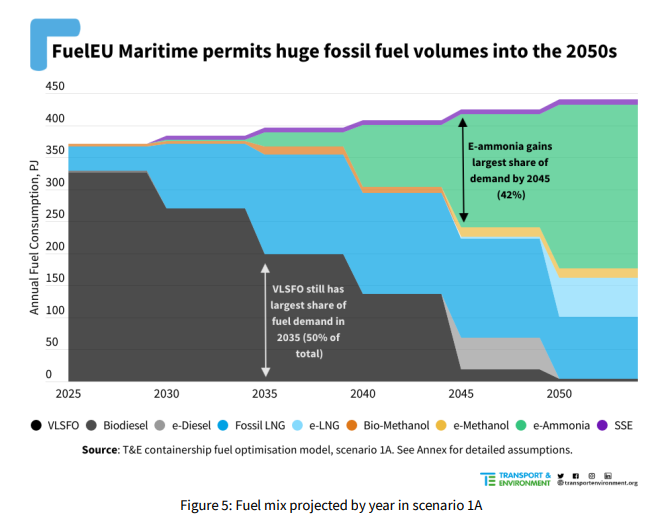According to a new report by Transport & Environment (T&E), EU’s landmark green shipping law will still leave the bloc dependent on fossil fuels beyond 2050.
The paper models the potential impact of FuelEU Maritime (in conjunction with the EU ETS), by showing how shipping companies might behave across the next 30 years in response to the legislation and future fuel pricing.
T&E recommends the next Commission and co-legislators to make a number of improvements to the ʻFit for 55ʼ package in the shipping sector:
- Align the greenhouse gas intensity (GHG) targets of FuelEU Maritime with a 1.5°C-compliant emissions trajectory from the global Science-Based Targets Initiative (SBTi).
- Set higher and additional RFNBO sub-targets for shipping, and remove the option for ships to use any advanced biofuels in place of RFNBOs; this would act as a stronger guarantee of demand for renewable fuels in the face of uncertainty over fuel prices, providing clarity to fuel suppliers.
- Set stronger penalties for non-compliance with the GHG intensity limits and RFNBO sub-targets in FuelEU Maritime, in order to discourage ʻpay-to-complyʼ as a viable alternative to fuel switching.
- Expand the FuelEU Maritime to include cargo and passenger vessels under 5,000 GT, as well as offshore vessels and other non-cargo ships. These ships made up an estimated 20% of WtW emissions in the EU in 2021.
- The LNG bunkering infrastructure mandate in the Alternative Fuels Infrastructure (AFIR) should be discontinued and replaced with mandates for fuels with a clearer pathway to sustainability, namely ammonia, methanol and hydrogen.
- The RFNBO supply target in RED III should be made mandatory in order to provide a minimum floor for the supply of sustainable fuels in maritime ports across Europe.
- Implement mandatory energy efficiency requirements on European shipping to bring down total fuel demand for a smooth transition.
T&E finds that under the existing regulation, the industry would see a slow transition away from polluting fossil fuels such as LNG, which ships could continue using into the 2050s, towards more sustainable e-fuels.
 T&E also notes the review of the EU’s FuelEU Maritime shows that EU shipping will fall behind where it needs to be in every decade up to and beyond 2050, meaning the sector will almost certainly overshoot the target of keeping global heating to 1.5 degrees.
T&E also notes the review of the EU’s FuelEU Maritime shows that EU shipping will fall behind where it needs to be in every decade up to and beyond 2050, meaning the sector will almost certainly overshoot the target of keeping global heating to 1.5 degrees.
In April this year, the EU passed the world’s most ambitious green shipping law to date, which among other things set a mandatory target for the sector of 2% green e-fuels by 2034. But T&E’s analysis shows that this is not ambitious enough and by 2040 fossil fuels will continue to power three-quarters of European shipping’s energy needs.

According to T&E, under the current law, 6% of shipping will run on green e-fuel by 2035 and this will rise to 24% by 2040.
To ensure the sector decarbonises on time, T&E suggests that the share of green e-fuels will need to be at least 18% and 85% in 2035 and 2040 respectively, alongside strong energy efficiency measures.
The EU’s failure to get shipping to zero by 2050 puts the bloc’s entire Green Deal at risk. Europe’s policymakers must go bolder and revise the targets immediately following next year’s European elections.
… said Alex Springer, shipping analyst at T&E





























































